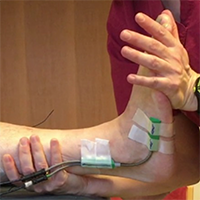 Smart Citations
Smart CitationsSee how this article has been cited at scite.ai
scite shows how a scientific paper has been cited by providing the context of the citation, a classification describing whether it supports, mentions, or contrasts the cited claim, and a label indicating in which section the citation was made.
Comparison of Spasticity in Spinal Cord Injury and Stroke Patients using Reflex Period in Pendulum Test
Spasticity is a motor impairment present in patients with both stroke and spinal cord injury. In this research, the results from the Wartenberg pendulum test, performed on stroke and spinal cord injury patients using goniometers and electromyogram recordings of the quadriceps, were reviewed and a new parameter to quantify spasticity was extracted. The Reflex Period (RP) of the pendulum test was defined as the time span from 50% of the maximum velocity of the leg swing to the activation of muscle contraction in the quadriceps, determined from the EMG. The results suggest that the reflex period in stroke patients is generally shorter than in those suffering from spinal cord injury.
Downloads
Citations
10.1080/01616412.2021.1950952
10.1186/s12984-022-01115-2
10.3389/fnhum.2020.602595
10.1080/01616412.2021.1939489
10.3390/brainsci11010007
10.5772/intechopen.112794
10.1080/01616412.2022.2149185
How to Cite
PAGEPress has chosen to apply the Creative Commons Attribution NonCommercial 4.0 International License (CC BY-NC 4.0) to all manuscripts to be published.

 https://doi.org/10.4081/ejtm.2019.8907
https://doi.org/10.4081/ejtm.2019.8907




